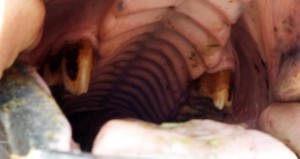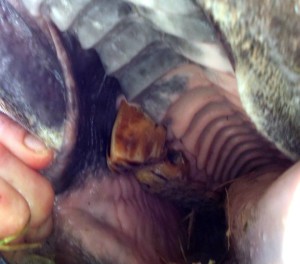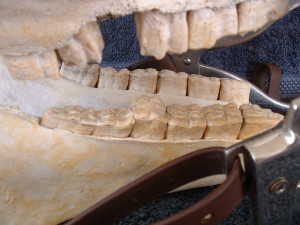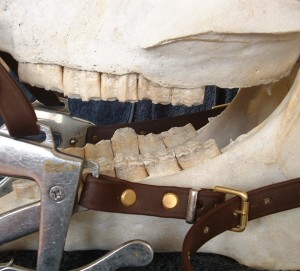Horse’s teeth are designed to continuously erupt throughout their lifetime, and are worn down from eating at roughly the same rate (approximately 2-5mm per year), although this can vary hugely depending on age and breed.
In an ideal mouth, all teeth would receive even wear, the horse would chew evenly on both sides, and the mouth would remain level and balanced. Unfortunately this is rarely the case and most horses develop sharp enamel points along the outside edge of the upper teeth and the inside edge of the lower teeth. Over time these sharp points become longer and protrude into the horse’s cheeks and tongue, causing sores and ulcers and extreme discomfort, especially when eating or being ridden.
There are many other protuberances, imbalances and common problems to be found such as hooks, ramps, waves, steps, lack of table angle/grind. Almost all of which can be prevented by having a routine check-up and float (rasp) every 10-12 months. This enables the teeth and entire jaw to maintain balance and comfort, thereby promoting –
- Pain free mastication
- Optimum digestion efficiency
- Good health and condition
- Control and safety when being ridden/driven
- A happy, well mannered horse
Some common dental problems in Equine’s
Ulcers– a break in the mucous membrane resulting in the exposure of deeper tissues, i.e. a sore inside the horse’s mouth.
All equines are prone to developing sharp cheek teeth enamel overgrowths, prominent vertical ridges which form on the outer aspect of the upper cheek teeth and the inner aspect of the lower cheek teeth. These sharp points traumatise the soft tissue of the cheek. As well as causing extreme pain and discomfort to the animal, severe cases can cause bitting problems, quidding and weight loss.
Hooks – a sharp narrow overgrowth or peak developed on a tooth through abnormal wear. Usually found on upper 06’s (first cheek tooth), and lower 11’s (right at the back), due to malocclusion (faulty-contact) of the upper and lower dental arcades. Found in horses which have overbite (parrot mouth), due to the upper cheek teeth being positioned forward (rostral) in relation to the lower cheek teeth row. Occasionally found on lower 06’s and upper 11’s in horses with underbite. Such overgrowths should be reduced at 6 monthly intervals.
Ramps – similar to hooks but have a less acute slope. Cause same problems as hooks.
Waves – undulations of the occlusal surface, often caused by an overpowering tooth/teeth, causing the row of cheek teeth to have a wavelike appearance. Can also form as a result of missing, displaced or rotated teeth in the opposing dental arcade, or from caps (deciduous teeth) not being shed at the correct time.
This skull shows a wave beginning to develop due to a missing tooth above.
Slight wave formations of the dental table can be corrected with a float/rasp, and are easy to manage if the patient is seen on a regular basis.
See Whiskeys’ case study for pictures of how teeth can wear if a wave is not corrected, and the result in later years of life.
Diastema – a space between two adjacent teeth. The occlusal surfaces of the cheek teeth rows are normally tightly compressed together, enabling the 6 cheek teeth in each row to function as one grinding unit. If spaces (diastemas) develop between these teeth then food impaction will occur. The huge forces of mastication cause progressively deeper impaction of long fibers. This will then cause pain and inflammation in the soft tissue, resulting in peridontal (gum) disease.
Peridontal disease – inflammation of the supporting structures of the tooth. Regarded as one of the most painful dental disorders in horses, it is the number 1 reason horses lose teeth, particularly in older horses. It is predominantly secondary to other disorders, such as diastema and displaced teeth.
Grind – proper sideways manipulation of feed via the mobile hinged lower jaw teeth evenly connecting to the immobile upper jaw teeth. ie. Contact between cheek teeth when chewing.
Grind is affected by any problems, pain or discomfort in the mouth, also by poor dentistry.
The upper and lower occlusal surfaces are angled to allow maximum contact between teeth. Reducing these natural angles can severely affect the horse’s ability to eat.





